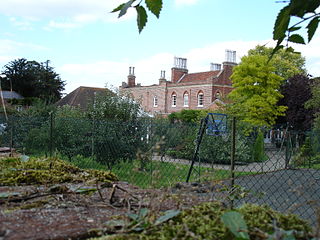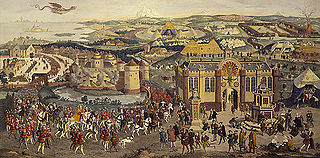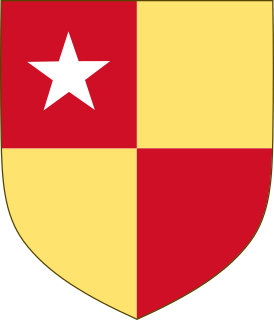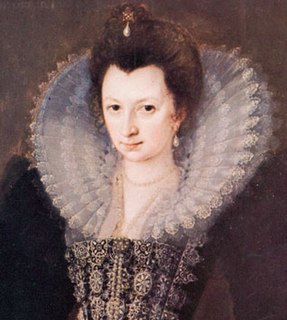
John de Vere, 12th Earl of Oxford, was the son of Richard de Vere, 11th Earl of Oxford, and his second wife, Alice Sergeaux (1386–1452). A Lancastrian loyalist during the latter part of his life, he was convicted of high treason and beheaded on Tower Hill on 26 February 1462.

John de Vere, 15th Earl of Oxford, Lord Great Chamberlain KG PC was an English peer and courtier.

Colne Priory at Earls Colne, Essex was a Benedictine priory, initially a dependent cell of Abingdon Abbey, Berkshire. It was founded by Aubrey de Vere I and his wife Beatrice in or before 1111. Their eldest son Geoffrey had died at Abingdon about seven or eight years earlier and was buried there. On his deathbed, Geoffrey had bequeathed to Abingdon the church and lands at Kensington, Middlesex, and his parents and brothers had confirmed that grant, as had King Henry I.

Richard de Vere, 11th Earl of Oxford KG was the son and heir of Aubrey de Vere, 10th Earl of Oxford. He took part in the trial of Richard, Earl of Cambridge and Lord Scrope for their part in the Southampton Plot, and was one of the commanders at Agincourt in 1415.
The following chart is a family tree of the Dukes of Norfolk, who were members of the Plantagenet, Mowbray and Howard families.

Frances Howard,, Countess of Surrey was the daughter of John de Vere, 15th Earl of Oxford, and Elizabeth Trussell. She married firstly, Henry Howard, Earl of Surrey, son of Thomas Howard, 3rd Duke of Norfolk, and his wife Elizabeth Stafford, by whom she had two sons and three daughters:

Elizabeth de Vere, Countess of Oxford was an English noblewoman. As a young child she became a royal ward. She married John de Vere, 15th Earl of Oxford, and by him was mother of the 16th Earl and grandmother of Sir Francis and Sir Horace Vere, the 'fighting Veres'.

John de Vere, 14th Earl of Oxford was an English peer and landowner.
Maud of Lancaster, Countess of Ulster was an English noblewoman and the wife of William Donn de Burgh, 3rd Earl of Ulster. She was the mother of Elizabeth de Burgh, suo jure Countess of Ulster. Her second husband was Sir Ralph de Ufford, Justiciar of Ireland. After Ufford's death, Maud became a canoness at an Augustinian nunnery, Campsey Priory, in Suffolk.
Maud de Ufford, Countess of Oxford was a wealthy English noblewoman and the wife of Thomas de Vere, 8th Earl of Oxford. Her only child was Robert de Vere, 9th Earl of Oxford, the favourite of King Richard II of England. In 1404 in Essex, she took part in a conspiracy against King Henry IV of England and was sent to the Tower of London; however, she was eventually pardoned through the efforts of Queen consort Joanna of Navarre.
Agnes de Launcekrona was Lady of the Bedchamber to Queen consort Anne of Bohemia. She became the second wife of Robert de Vere, 9th Earl of Oxford, a favourite of King Richard II of England.
Bridget de Vere, Countess of Berkshire was an English noblewoman, the daughter of Edward de Vere, 17th Earl of Oxford. Bridget was brought up by her maternal grandfather, the powerful statesman William Cecil, 1st Baron Burghley. She was also styled Lady Norris of Rycote and Viscountess Thame. She married Francis Norris, 1st Earl of Berkshire; however, the marriage was not a success, and they separated in 1606.

Anne Cecil, Countess of Oxford was the daughter of the statesman William Cecil, 1st Baron Burghley, chief adviser to Queen Elizabeth I of England, and the translator Mildred Cooke. In 1571 she became the first wife of Edward de Vere, 17th Earl of Oxford. She served as a Maid of Honour to Queen Elizabeth before her marriage.
Elizabeth Norris, 3rd Baroness Norreys of Rycote, suo jure was an English noblewoman and a baroness. She was the wife of Edward Wray, Groom of the Bedchamber to King James I of England, with whom she eloped in 1622, and incurred the king's displeasure as she was his royal ward. Elizabeth and her elopement was allegedly the inspiration for Orlando Gibbons Fantazies.

Susan de Vere, Countess of Montgomery, was an English court office holder. She served as lady-in-waiting to the queen consort of England, Anne of Denmark. She was the youngest daughter of Elizabethan courtier, poet, and playwright Edward de Vere, 17th Earl of Oxford.
Margery Golding, Countess of Oxford was the second wife of John de Vere, 16th Earl of Oxford, the mother of Edward de Vere, 17th Earl of Oxford, and the half-sister of Arthur Golding, the English translator.

The de Vere family were an English aristocratic family who derived their surname from Ver, in Lower Normandy, France. The family's Norman founder in England, Aubrey (Albericus) de Vere, appears in Domesday Book (1086) as the holder of a large fief in Essex, Cambridgeshire, Huntingdonshire, and Suffolk. His son and heir Aubrey II became Lord Great Chamberlain of England, an hereditary office, in 1133. His grandson Aubrey III became Earl of Oxford in the reign of King Stephen, but while his earldom had been granted by the Empress Matilda and eventually recognised by Stephen, it was not until January 1156 that it was formally recognised by Henry II and he began to receive the third penny of justice from Oxfordshire.
The Countess of Derby usually refers to the wife or widow of an Earl of Derby, such as:










